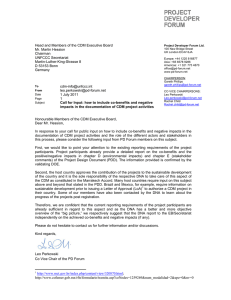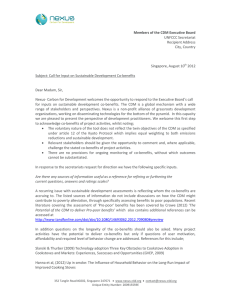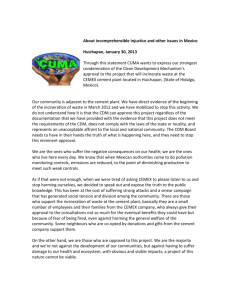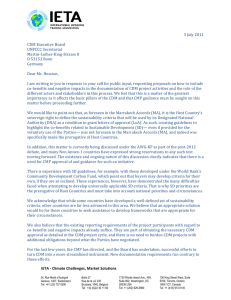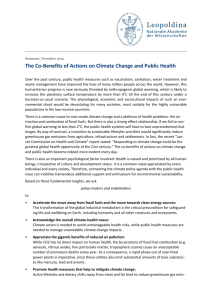Co-benefits of CDM projects in China
advertisement
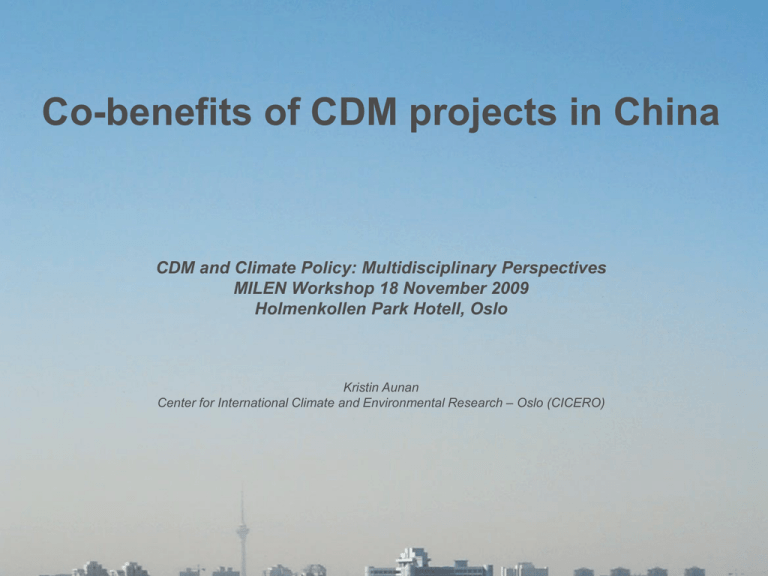
Co-benefits of CDM projects in China CDM and Climate Policy: Multidisciplinary Perspectives MILEN Workshop 18 November 2009 Holmenkollen Park Hotell, Oslo Kristin Aunan Center for International Climate and Environmental Research – Oslo (CICERO) 1 Outline • Emissions of CO2 and air pollutants in China • Air pollution co-benefits of CO2 mitigation • Co-benefits of China’s current CDM portfolio 2 Outline • Emissions of CO2 and air pollutants in China • Air pollution co-benefits of CO2 mitigation • Co-benefits of China’s current CDM portfolio 3 China dominates global emissions and emissions growth CO2 from fossil fuels (GtC/yr) • China1990: 11% 2.50 2.00 USA 1.50 EU Japan Other developed countries 1.00 FSU China India 0.50 0.00 Other developing countries of global emissions • China 2008: 22% • Global emissions growth 20072008: China’s share was 70% Myhre et al., 2009 4 Half of the growth in CO2 towards 2030 may come from China • ~80% of the growth in emissions 20052030 from developing countries • ~60% from developing Asia • ~40% from China alone • (NB: These are BAU scenarios..) 5 Power plants and industry largest sources of emissions of CO2, SO2, and NOx CO2 SO2 Power plants Power plants Iron and Steel Iron and Steel Cement Cement Other industry Other industry Transport Transport Residential Residential NOx Power plants Iron and Steel Cement Other industry Transport Residential Peters et al. (2009) based on China Statistical Yearbook 6 Outline • Emissions of CO2 and air pollutants in China • Air pollution co-benefits of CO2 mitigation • Co-benefits of China’s current CDM portfolio 7 ’Co-benefits’: Climate-change and airpollution links • Source link: CO2 and the main air pollutants have the same sources • Air pollutants, especially tropospheric ozone and particles, play an important role in the climate system • Chemistry: Some air pollutants affect the lifetimes of GHGs 8 ’Co-benefits’: Climate-change and airpollution links • Source link: CO2 and the main air pollutants have the same sources • Air pollutants, especially tropospheric ozone and particles, play an important role in the climate system • Chemistry: Some air pollutants affect the lifetimes of GHGs 9 Co-benefits include: • Avoided mortality and morbidity due to exposures to air pollution • Avoided corrosion to materials and heritage due to acid rain • Avoided damage to crops and ecosystems due to surface ozone and acid rain • Avoided costs in air pollution abatement • Avoided climate disturbance Beijing, november 2007 from air pollutants (PM, O3…) 10 Air pollution co-benefits of CO2 mitigation in developing countries are well documented • US-EPA IES program: – Co-control options accounting for health co-benefits (Argentina, Brazil, Chile, China, India, Mexico, Phillippines, South Korea.. ) • IGES (Institute for Global Env. Strategies): – Research on co-benefits of climate actions in the Asia-Pacific region • Clean Air Initiative: Asia • IIASA (Gains model) • Academic scholars/publications: – Health and environmental co-benefits of GHG mitigation often exceed the costs – Air pollutants as a climate forcing (trade-offs!) 11 Avoided deaths/mtCO2 0 50 100 150 200 250 300 350 400 China (O'Connor et al., 2003) China (Garbaccio et al, 2000) India (Bussolo and O'Connor, 2001) Hungary (Aunan et al., 1998) Chile (Dessus and O'Connor 1999) Chile (Cifuentes et al., 1999) USA (Abt Associates, 1997) LOCAL PROJECTS, CHINA: (Mestl et al, 2005; Aunan et al., 2004) Co-generation heat and electr. Industrial boilers (energy efficiency) Coal washing Coal briquettes replace raw coal in cooking/heating Steel work - low stack sources 665 Steel work - high stack sources District heating 12 IPCC AR4 concludes: “..in all analyzed world regions near-term health co-benefits from reduced air pollution as a result of actions to reduce GHG emissions can be substantial and may offset a substantial fraction of mitigation costs (high agreement, much evidence)” 13 Outline • Emissions of CO2 and air pollutants in China • Air pollution co-benefits of CO2 mitigation • Co-benefits of China’s current CDM portfolio 14 China by far the largest CDM country Figure: Volumes of proposed CDM project emissions reductions, through 2012. Source:Point Carbon 2009 15 • Draws upon studies on health and environmental co-benefits of CO2 reductions in China (energyrelated, potential CDM) • Exploiting China’s CDM potential (energy): 3,00040,000 premature deaths avoided each year, and • 1-45 billion RMB saved due to avoided morbidity and hospitalization, crop loss, material damage… 16 A simplified methodology for estimating cobenefits of current Chinese CDM portfolio (Rive and Aunan, 2009, work in progress) • Statistical sampling from the 1754 active CDM projects in China as of July 1st 2009 (UNEP CDM Pipeline database) – categorized according to project type and geographical location 17 CERs from China’s CDM portfolio (2010) Energy efficiency Forestry (Supply-side and 0% Industry) 1% Energy efficiency (Own generation at plant level) N2O 12 % 9% Cement 0% Zero Emission Renewables 37 % South 12 % North West 8% North East 12 % F-Gas 21 % Coal bed methane 8% Fossil fuel switch 7% Biomass (crop residues in PP) 4% Waste (e.g. biogas) 1% Central 18 % East 25 % North 25 % Hainan 0% 18 A simplified methodology for estimating cobenefits of current Chinese CDM portfolio (Rive and Aunan, 2009, work in progress) • Sample from the 1754 active CDM projects in China as of July 1st 2009 (UNEP CDM Pipeline database) – categorized into project type and geographical location • From information in the Project Design Document and emission factors in GAINS-Asia database: coabatement rate for SO2, PM2.5, and Nox re estimated 19 Co-control rate for project types Energy eff. (Supply-side and Industry) Energy eff. (Own production at plant level) Fossil fuel switch Biomass PP (crop residues etc) Zero Emission Renewables tSO2/ktCO2 Waste tNOx/ktCO2 Coal bed methane tPM2.5/ktCO2 Cement -2 0 2 4 6 8 10 12 14 16 18 (Based on Rive and Aunan, 2009, work in progress) 20 Energy efficiency (Supply-side and Industry) Cement 3 % 0% PM2.5 Forestry 0% Total offsets of air pollutants (2010) N2O 0% F-Gas 0% Coal bed methane 2% SO2 Forestry 0% Cement 0 % N2O 0% Energy efficiency (Own generation at plant level) 16 % F-Gas 0% Zero Emission Renewables 47 % Fossil fuel switch 22 % EE Supply-side and Industry 2% EE Own Generation 17 % Zero Emission Renewables 49 % Fugitive 3% FF Switch 23 % Biomass 10 % Energy efficiency (Supply-side and Industry) 8% Waste 0% NOx Biomass 6% Forestry 0% Waste 0% N2O 0% Energy efficiency (Own generation at plant level) 19 % Cement 0% F-Gas 0% Coal bed methane 2% Fossil fuel switch 1% Biomass 7% Zero Emission Renewables 63 % Waste 0% 21 Total offsets: Annual CO2 reductions and coabated air pollution • CER in 2008: ~2% of China’s CO2 emissions from fossil fuels 3000 2500 • SO2 reduction from CER Generation (MtCO2eq) SO2 Offsets (ktSO2) 2000 CDM in 2010: ~20% of China’s targeted SO2 reduction in 11th five year plan PM Offsets (ktPM2.5) NOx Offsets (ktNOx) 1500 1000 • PM2.5 and NOx: Small 500 0 2003 2004 2005 2006 2007 2008 2009 2010 2011 2012 share of total emissions, but large co-benefits 22 A simplified methodology cont., health (premature mortality) • Assume an average 0.10 avoided deaths per tPM2.5 for energy related ‘CDM type projects’ in China (from Vennemo et al. 2006). This is 2.6 times the figure estimated for general PM2.5 reductions in Europe in the CAFE Programme • Adjust according to project type (ie. height and dispersion of emission – ’intake fraction’ (from Ho and Nielsen, 2007) and region (i.e. population density (from Tan et al. 2008) 23 Avoided deaths rate for project types and regions Aggregate results for five types of offsets: Grid offsets; Point sources (biomass+non-biomass); Transport; Biomass open burning Avoided deaths from reduced PM2.5 exposure/tCO2 Energy eff. (Supply-side and Industry) Energy eff. (Own production at plant level) South Fossil fuel switch North West North East Biomass (crop residues in PP) North Zero Emission Renewables (hydro, wind..new PP) Hainan East Waste Central Coal bed methane Cement -0.05 0.00 0.05 0.10 0.15 0.20 0.25 0.30 0.35 (Based on Rive and Aunan, 2009, work in progress) 24 A simplified methodology cont., agricultural crop loss • A reduced form model for the NOx→surface ozone → crop loss link for China based on Aunan et al. (2000) was applied to estimate avoided crop loss from a nationwide CO2 tax in China in Vennemo et al. (2009): Average avoided crop loss per ktNOx associated with a CO2-tax: 0.026 mill Yuan (2005)/tNOx 25 Co-benefit rate of China’s CDM portfolio 2010 (€/tCO2eq) Energy eff. (Supply-side and Industry) Health benefit Energy eff. (Own production at plant… Avoided crop loss Fossil fuel switch Biomass (crop residues in PP) Zero Emission Renewables (hydro,… Waste CER cost ~10-15 Euro/tCO2eq Coal bed methane Cement -2 0 2 4 6 8 10 12 14 16 18 (Based on Rive and Aunan, 2009, work in progress) 26 Sensitivity: Use of iF weighting reduces the health damage estimates; use of geographical weighting enhances them) Figure: No weighting Energy eff. (Supply-side and Industry) Health benefit Energy eff. (Own production at plant level) Avoided crop loss Fossil fuel switch Biomass (crop residues in PP) Zero Emission Renewables (hydro, wind..new PP) Waste Coal bed methane Cement -2 0 2 4 6 8 10 12 14 16 Euro/tCO2eq 27 Total benefit (avoided deaths and crop loss) of CDM in China (2010): 14 billion RMB (~1.4 bill €) Total benefit (RMB) EE Supply-side and Industry 7% Cement 0% N2O 0% Forestry 0% EE Own Generation 18 % F-Gas 0% Coal bed methane 2% FF Switch 10 % Waste 0% Zero Emission Renewables 55 % Biomass 8% 28 Value of co-benefits vs value of CERs Forestry EE Supply-side and Industry Value of CER (bill RMB) EE Own Generation N2O Health and crop co-benefit (bill RMB) Cement F-Gas Coal bed methane FF Switch Waste Biomass Zero Emission Renewables -5 0 5 10 15 20 29 Conclusions • Energy related CDM projects in China bring substantial health and environmental co-benefits, on average worth maybe ~1/3 of the CERs’ value • Energy efficiency in industry and power production has the largest co-benefit rate per ton CO2 • Zero-emissions renewables (wind, new solar and hydro..) currently bring the largest cobenefits • PDD currently not required to provide AP impacts – perhaps they should? 30
